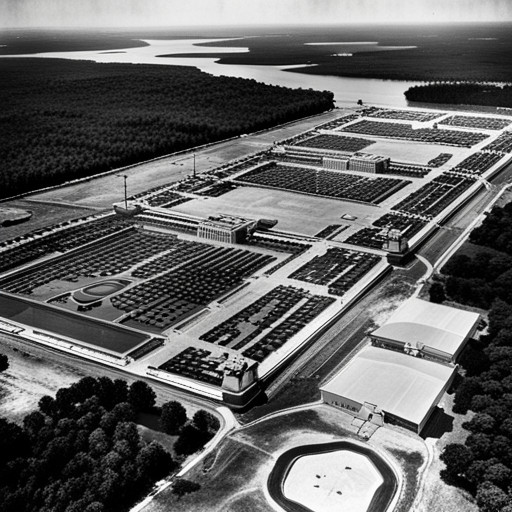From Clear Water to Silent Killer: A Close Look at Carcinogens at Camp Lejeune
This article examines the historical water contamination at Camp Lejeune, tracing the sources of pollution and identifying the carcinogens involved.

The health impacts on residents are analyzed, providing insights into risks associated with exposure.
Lastly, potential solutions to this alarming issue are discussed, demonstrating the need for urgent attention to environmental safety in military installations.
Key Takeaways
- Camp Lejeune's water contamination issue was a result of improper disposal of hazardous chemicals, leading to the presence of carcinogens such as trichloroethylene, tetrachloroethylene, and benzene.
- Residents of Camp Lejeune faced increased risks of cancer due to exposure to these carcinogens, with elevated incidences of leukemia, kidney cancer, liver cancer, and non-Hodgkin lymphoma.
- Steps towards addressing the contamination issue include the use of filtration systems and research into water remediation processes, as well as the need for strict monitoring systems and accountability in military operations.
- Comprehensive strategies for resolving the issue involve improved regulation of water quality standards, enhanced surveillance systems, comprehensive health support services, policy changes, and proactive measures for environmental stewardship and health support.
Understanding the History of Camp Lejeune

Established in 1941, Camp Lejeune has a complex history that is integral to understanding the current issues surrounding water contamination and its impact on residents. The base establishment was initiated in response to the expanding military operations during World War II. This particular site was chosen due to its proximity to port facilities, providing strategic advantage for the United States Navy.
The base played an instrumental role in various military operations throughout the years – from World War II through the Cold War, the Vietnam War, and more recent conflicts. With this purpose came rapid development and infrastructure expansion, including housing accommodations, training buildings, and utility systems such as water treatment plants.
Water supply at Camp Lejeune initially relied heavily on wells drawing from groundwater sources. However, with increased population pressure due to intensifying military operations over time, demand for clean water escalated rapidly, leading to potential compromises in water quality management.
In retrospect, it appears that this high demand, coupled with inadequate control measures, may have given rise to water contamination issues. Hazardous chemicals were reportedly disposed of improperly within the camp boundaries, which eventually percolated into groundwater resources used by residents.
Tracing the Source of Contamination at Camp Lejeune

Investigation into the origins of the toxic contamination has revealed a complex web of potential sources. A significant body of evidence implicates military negligence as a key factor in this environmental catastrophe. The contamination at Camp Lejeune, which was discovered in the 1980s, is believed to have originated from various hazardous substances improperly disposed of by military operations over several decades.
The primary contaminants were volatile organic compounds (VOCs), including trichloroethylene, tetrachloroethylene, and benzene, all carcinogenic substances linked to multiple health issues such as liver damage, cancer, and neurological effects. Many experts believe these VOCs leached into the groundwater due to improper storage and disposal practices implemented by the base's personnel.
Moreover, there are allegations suggesting a contamination cover-up by military officials who were aware of the presence of harmful substances but chose not to alert those who might be affected. Reports indicate that test results showing high levels of contaminants in water supplies were dismissed or buried in bureaucracy for years before their eventual public release.
Given these findings, it can be inferred that while other minor contributors might exist, military negligence coupled with an alleged cover-up effort remain central factors behind this extensive pollution event. However, further research is required to fully uncover all aspects of this tragic incident at Camp Lejeune. Attributing blame could guide future policies aimed at preventing similar incidents and ensuring timely accountability for any failings.
Identifying the Carcinogens Found in Camp Lejeune’s Water

Identification of the toxic substances present in the contaminated environment revealed a high concentration of volatile organic compounds, notably trichloroethylene, tetrachloroethylene, and benzene; these are known carcinogens associated with numerous health issues. Detection was facilitated using advanced carcinogen detection methods such as gas chromatography-mass spectrometry (GC-MS) and high-performance liquid chromatography (HPLC). These techniques helped to identify and quantify the levels of these harmful substances.
The presence of these carcinogens in Camp Lejeune's water supply presents significant health risks. Exposure to trichloroethylene has been linked to kidney cancer and non-Hodgkin lymphoma; tetrachloroethylene is associated with bladder cancer, while benzene can cause leukemia and other blood cell cancers. Therefore, understanding their concentrations is imperative for mediating potential health impacts.
To address this situation, water purification techniques have been employed at Camp Lejeune. The application of activated carbon filtration systems proved efficient in removing volatile organic compounds from water supplies. This approach uses porous carbon to adsorb contaminants onto its surfaces, thereby reducing their concentrations in the water.
Furthermore, research into advanced oxidation processes (AOPs) shows promise for future remediation efforts. AOPs involve generating reactive species capable of breaking down difficult-to-remove pollutants into less harmful substances.
Examining the Health Impacts of Carcinogens on Camp Lejeune Residents

Exposure to volatile organic compounds, specifically trichloroethylene, tetrachloroethylene, and benzene, has been observed to significantly increase the risk of developing various types of cancer among residents previously residing in contaminated sites. Research illuminates these carcinogens' impact on biological processes that could potentially create malignant mutations.
Detailed analysis reveals that trichloroethylene exposure can disrupt DNA replication and repair mechanisms in body cells, causing abnormal cell growth. Similarly, tetrachloroethylene is found to have a genotoxic effect, leading to DNA damage and chromosomal aberrations. Additionally, benzene poses a significant health threat due to its ability to form reactive metabolites capable of binding with DNA and inducing carcinogenesis.
Residents' experiences at Camp Lejeune substantiate these scientific findings as they have battled various health complications linked with such contamination. Epidemiological studies concerning this population demonstrate elevated incidences of cancers, including leukemia, kidney cancer, liver cancer, and non-Hodgkin lymphoma. Moreover, there are reported cases of rare diseases like male breast cancer, which further accentuate the severe implications of prolonged exposure.
The adverse health outcomes observed provide compelling evidence for the toxic effects of these volatile organic compounds present in water supplies at Camp Lejeune. This unfortunate episode spotlights the necessity for stringent monitoring systems to prevent future instances where communities are exposed unsuspectingly to hazardous substances, leading to detrimental health consequences.
Steps Towards Addressing the Camp Lejeune Water Contamination Issue

Addressing the contamination issue requires multifaceted strategies, such as improved regulation of water quality standards, enhanced surveillance systems for early detection of contaminants, and comprehensive health support services for those affected. In the case of Camp Lejeune, remediation efforts have been initiated to address the toxic legacy of decades of water contamination.
Policy changes are an integral part of these efforts. Adopting more stringent water quality regulations is fundamental in preventing the recurrence of such catastrophic events. The enforcement of these policies would necessitate periodic monitoring and testing to ensure compliance with set standards.
Furthermore, surveillance systems can play a vital role in mitigating future risks. Incorporation and utilization of advanced technologies could facilitate early detection and prompt response to potential contaminant sources before they escalate into significant public health threats.
In addition to preventive measures, addressing the aftermath remains paramount. Comprehensive health support services must be extended to those affected by the contamination incident at Camp Lejeune. This could entail specialized medical care targeting conditions linked to exposure to carcinogens and other harmful substances present in contaminated water supplies.
These recommendations represent foundational steps towards tackling the complex issue at hand. However, their successful implementation hinges on sustained commitment from respective authorities coupled with active participation from all stakeholders involved in safeguarding public health.
Frequently Asked Questions
What Legal Resources Are Available for Those Affected by the Water Contamination at Camp Lejeune?
Legal resources for individuals affected by water contamination at Camp Lejeune include legal advocacy groups and processes for filing compensation claims under several federal regulations and health benefits programs.
Are There Any Ongoing Studies About the Long-Term Health Effects of the Contaminants Found in Camp Lejeune’s Water?
There are ongoing studies investigating the long-term health repercussions of contaminant effects found in Camp Lejeune's water, exploring potential links to diseases such as cancer, birth defects, and other serious conditions.
How Did the Water Contamination at Camp Lejeune Impact the Local Ecosystem and Wildlife?
The water contamination at Camp Lejeune significantly disrupted the local ecosystem, necessitating extensive recovery efforts. Adverse effects on wildlife were substantial, prompting ongoing rehabilitation initiatives to restore biodiversity and ecological health.
Are There Any Similar Cases of Water Contamination in Other Military Bases in the United States?
Indeed, multiple instances of water contamination exist across US military bases, presenting significant base health risks. These cases illustrate the urgent need for increased contamination accountability within military infrastructure management practices.
What Steps Have Been Taken to Prevent Similar Incidents of Water Contamination in the Future?
Future legislation has been enacted to enhance contamination monitoring at military bases. This includes rigorous testing protocols, improved infrastructure, and stricter guidelines for the safe disposal of toxic substances to prevent future water contamination incidents.
Conclusion
The contamination issue at Camp Lejeune highlights significant environmental health concerns. The presence of carcinogens in the water supply has had profound health impacts on residents, necessitating urgent remedial measures.
It is critical to continue investigations and interventions to prevent similar occurrences in other military bases worldwide.
This case highlights the need for stringent regulations and monitoring mechanisms to safeguard public health from environmental hazards.




